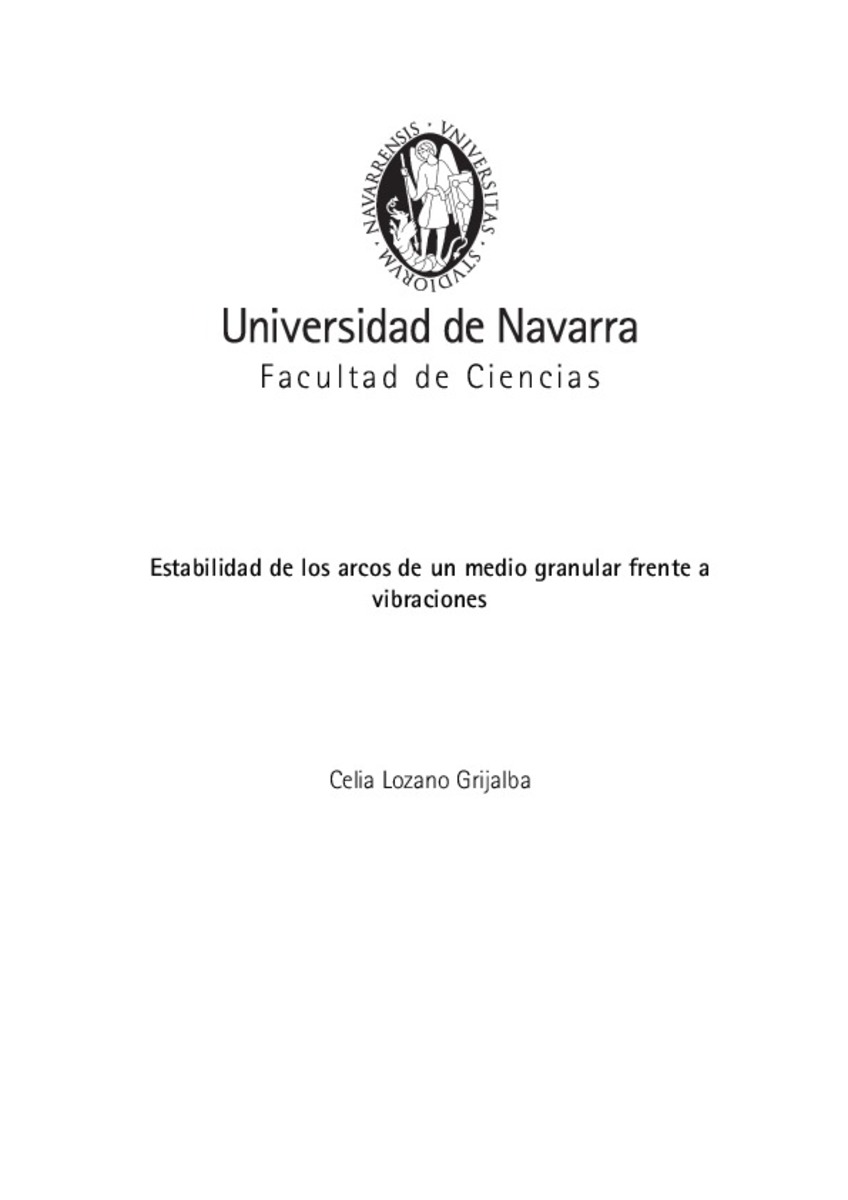Registro completo de metadatos
| Campo DC | Valor | Lengua/Idioma |
|---|---|---|
| dc.contributor.advisor | Zuriguel-Ballaz, I. (Iker) | - |
| dc.contributor.advisor | Montero, Á. (Ángel) | - |
| dc.creator | Lozano, C. (Celia) | - |
| dc.date.accessioned | 2014-12-04T16:28:06Z | - |
| dc.date.available | 2014-12-04T16:28:06Z | - |
| dc.date.issued | 2014 | - |
| dc.date.submitted | 2014-09-11 | - |
| dc.identifier.citation | LOZANO GRIJALBA, Celia. “Estabilidad de los arcos de un medio granular frente a vibraciones”. Zuriguel, I. y Garcimartín, Á. (dirs.). Tesis doctoral. Universidad de Navarra, Pamplona, 2014 | es_ES |
| dc.identifier.uri | https://hdl.handle.net/10171/37150 | - |
| dc.description.abstract | In this experimental work on granular materials, we study the stability of arches blocking the exit of a silo against external vibrations. When a group of particles flow through a bottleneck, they are prone to spontaneously developing clogs, even if the orifice size is greater than the particles. This is due to the formation of arrangements of mutually stabilizing sets of grains that appear at the bottleneck, which are called arches. To restore the flow, those arches must be shattered by an external perturbation. This study aims at investigating this process. An arch collapses because one particle is separated from the others. A detailed analysis reveals that the main factor determining the arch stability is the angle between one grain and its neighbours, Ø: the arches preferably break at the bead with maximum angle, Ømax. The acceleration needed to break an arch is called Gamma. The experiments show that the higher the maximum angle, the easier it is to break the arch. This relationship is the same regardless of the orifice size, the rate of the acceleration ramp and the material of which particles are made. Although Gamma seems to depend on other properties of the arch, this relationship is indirect and is only due to the influence of these properties on Ømax. Furthermore, for the cases where max in the arch is above 180º -which are called defects- we have introduced a simple model that resorts to the forces in the arch to explain the observed behaviour. The study of the time that an arch can resist to a constant vibration shows that its distribution has a power-law tail, indicating that there is no characteristic time scale. Depending on the value of the exponent alpha, a clogged state (if alpha>2) or unclogged state (if alpha>2) can be defined. Thus, a transition from a clogged to an unclogged state may be obtained by increasing the intensity of the vibration Gamma, enlarging the outlet size or reducing the layer of grains above the clogging arch. In other words, the clog is hindered if the opening is enlarged, the compatible load is diminished or the incompatible load is increased. This knowledge could be the starting point for further research on other systems that get clogged. | es_ES |
| dc.language.iso | spa | es_ES |
| dc.publisher | Servicio de Publicaciones de la Universidad de Navarra | es_ES |
| dc.rights | info:eu-repo/semantics/openAccess | es_ES |
| dc.subject | Materias Investigacion::Física | es_ES |
| dc.subject | Mecánica de medios continuos | es_ES |
| dc.title | Estabilidad de los arcos de un medio granular frente a vibraciones | es_ES |
| dc.type | info:eu-repo/semantics/doctoralThesis | es_ES |
Ficheros en este ítem:
Estadísticas e impacto
Los ítems de Dadun están protegidos por copyright, con todos los derechos reservados, a menos que se indique lo contrario.






